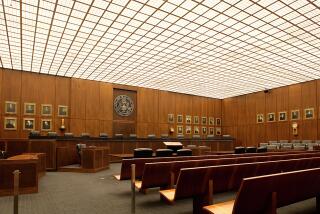Lawyer’s Use of Client’s Assets Investigated : Courts: The State Bar is examining possible misconduct and financial abuse of Anaheim widow’s $24-million trust.
- Share via
IRVINE — The State Bar of California is investigating whether a prominent Irvine lawyer took unfair advantage of an 86-year-old Anaheim widow and improperly gained exclusive control of her $24-million estate, using it as a bountiful source of fees for himself and his family.
Under scrutiny is Lloyd G. Copenbarger, 51, perhaps best known statewide among evangelical churches for offering financial seminars as an “experienced Christian estate planning attorney.”
Court records and official documents reveal that the State Bar’s investigation, which began two years ago and which could cost Copenbarger his license, includes allegations that he violated the legal profession’s code of conduct while handling the Hazel I. Maag estate.
Copenbarger dismisses the allegations as “without foundation,” “despicable in nature” and “misleading garbage.”
His management of Maag’s assets, which he described as being in line with her wishes, has been questioned by her relatives, two Orange County Superior Court judges and two court-appointed attorneys who have looked into the matter.
Copenbarger and his attorneys argue that many, if not all, of those questioning his actions are motivated by self-interest.
“Anyone can make an allegation. All you need is a personal computer and a pen,” said attorney Paul Copenbarger, who was hired and paid with estate funds to defend his older brother’s right to control the estate. “In this case, court pleadings are being used as a platform to launch attacks with impunity.”
Citing secrecy rules, State Bar officials declined to comment. Probate court records show that they are reviewing complaints that Copenbarger hired relatives at the estate’s expense, misused client funds, billed the estate exorbitant amounts for fees and expenses and made decisions that went against his client’s interests.
One important issue is whether Maag, the descendant of Orange County pioneers and one of the area’s last citrus growers, was mentally capable when she entrusted Copenbarger with her assets only a few weeks after meeting him in late 1986.
At the time, Maag was a frugal and irascible widow who lived alone on a 23-acre citrus ranch in Anaheim. Though she liked to refer to herself as “just a farmer,” she had built up a $24-million estate that included stock, commercial buildings and landholdings.
Her closest relatives at the time were nieces Barbara Bell and Hazel Rosenbaum, both of Orange County, and their 10 children. In 1964, Maag signed a will that left half of her estate to Bell and Rosenbaum, a quarter to the Tumor Clinic of the California Hospital in Los Angeles, and the remainder to relatives whom she outlived. A few thousand dollars were to go to a church and a social club.
The will remained in force for more than 22 years until she was introduced to Copenbarger in November, 1986. Copenbarger helped Maag create a living trust and execute documents that by January, 1987, gave him power of attorney over her affairs and exclusive control over her trust if she became incapacitated.
Virtually all of her estate was earmarked for the Hazel I. Maag Foundation, which Copenbarger would direct, paying himself “reasonable compensation without” court oversight. The redrawn will left about $650,000 for Maag’s nieces to share. Magg died last May.
According to court records, six people have said in sworn statements that Maag was having difficulty conducting her personal affairs by the time Copenbarger became her attorney. Five people have said in depositions that the plan to leave her assets to a charitable foundation, with no designated beneficiaries, is hard to reconcile with her past decision to leave the bulk of her estate to relatives.
“Copenbarger doesn’t deserve it,” said Laura Fox, Maag’s grandniece, whose mother received half of a tax-paid, $2.6-million settlement paid by Copenbarger, with another $600,000 going for their attorneys’ fees. “The estate is worth more than $20 million now, but it’s not the money. Every time I drive by her ranch, I know I can’t walk through it anymore.”
Even before she was introduced to Copenbarger in the mid-1980s, relatives and acquaintances said, Maag claimed to hear the voices of dead acquaintances, accused people of doing things they never did, threw away her bills, could not read well and had bouts of confusion. Because she refused to have her plumbing fixed at the ranch, they said, she went to the bathroom in a bucket, which she emptied in one of her orange groves.
Because of Maag’s failing health and mental condition, lawyer Michael D. Pursell, who was appointed in October, 1990, by an Orange County Superior Court judge to represent her interests, argued in court documents that Maag might have been particularly vulnerable to Copenbarger’s influence.
According to documents and interviews with family members, Maag reportedly told a relative that Copenbarger once locked her in his law office for hours until she relented and signed legal papers she did not understand.
And, in a tape-recorded conversation between Maag and Copenbarger that came to light during probate court proceedings, Maag is heard telling him: “I can’t read. Don’t ask me to read, ‘cause I can’t see a thing. I’m going totally blind. I guess that’s the way you like me--blind.”
Copenbarger denies any impropriety, saying that Maag knew what she owned and fully understood the estate plans he prepared, therefore fulfilling the legal requirements for mental competency. He recalled that there were various disputes in the family and that Maag clearly wanted to change her will so that most of her estate would go to charity.
“I did everything in my power to heal the (family) problems that existed,” Copenbarger said. “I encouraged Hazel to increase the provisions she was making (in her will) to her relatives and I encouraged (her relatives) to expand their contacts with their aunt.”
He cited the sworn statements by at least six of Maag’s acquaintances, relatives and associates who said they thought Maag was mentally sound. Two of those people told The Times they were not qualified to judge her mental condition and regret having signed the statements.
Copenbarger said he began recording conversations with Maag in 1987 because he believed her relatives were going to raise the issue of mental competency. The part where she talks about being blind, he said, has been taken out of context.
“She was pretty unhappy” at the moment, he said. “People in the area were putting trash on her property and going on her property to steal her oranges. She was venting her frustrations. . . . I have no idea what she meant. She was annoyed because she was getting old. . . . She railed at death.”
The question of Maag’s mental competency became a legitimate concern in 1989, he said, because of several medical crises, including a stroke that incapacitated her.
At the time, Copenbarger was to have become Maag’s conservator, or legal guardian, under her estate agreements. But niece Bell filed a court action, urging that someone other than him be appointed.
Within two months, the attorney fired back with a lawsuit against Bell, contending that she and other relatives were trying to thwart Maag’s wishes and recoup their share of the 1964 will. He said that the revised will was valid and that Maag was legally competent when she signed the documents.
During the ensuing court fight, Superior Court Judge James A. Jackman appointed lawyer Seymour S. Pizer, now deceased, as a special master in August, 1989, to review the situation and help the court decide whether an independent conservator should be appointed.
Pizer recommended that someone other than Copenbarger “would be in the best position to protect the interest of Mrs. Maag without the inference of any self-dealing or interest in the estate.”
Pizer said Copenbarger had gained broad, unsupervised control over Maag’s affairs, for which he was drawing fees. Pizer also noted that Copenbarger had hired relatives to provide legal counsel as well as to supervise Maag’s health care and ranch operations.
For his lawsuit against Bell, Copenbarger employed his younger brother, Paul, at estate expense. Lloyd Copenbarger’s son, Larry, and daughter-in-law, Judi, both law students, were hired to watch over Maag and her ranch.
As Pizer had recommended, the court in February, 1990, appointed a conservator for Maag, Lura O. Scoville. Eight months later, then-Presiding Superior Court Judge James L. Smith named Pursell to act as an independent attorney for Maag.
“People were asking why was (Copenbarger) wearing all these hats,” said Ernest Hayward, an attorney for Scoville.
Hayward said that Copenbarger would not disclose the charities that would receive funds from the Hazel I. Maag Foundation.
“I could never get from him a list of charities that would benefit so we were left to suppose. My supposition was that it would fund religious organizations and schools that were associated with Mr. Copenbarger,” Hayward said.
Copenbarger said there was nothing wrong with his reluctance to name the charities to benefit from the Maag foundation, adding that he will decide on the basis of Maag’s wishes. But “the time is not yet ripe to make that decision,” he told The Times.
In December, 1991, he agreed to settle the lawsuit with Maag’s nieces, Bell and Rosenbaum. They accepted $1.3 million each, and the promise that Copenbarger would pay any taxes due and their legal fees of $600,000. Because of an agreement to keep silent, the Bell and Rosenbaum families declined to discuss why they settled the case.
On May 6, 1992, two days after Maag’s death, Pursell filed a report raising another round of questions about Copenbarger that were similar to those of Pizer, the special master.
Of particular significance, Pursell questioned trustee and attorney fees paid by the estate to Copenbarger and his relatives from 1989 to 1991 as being exorbitant, unjustified and perhaps illegal. Hundreds of thousands of dollars in expenditures for Maag’s properties were questioned as well.
“It should be noted,” Copenbarger stated in court records, “that despite the intense scrutiny to which these (fee) statements have been subjected by several examiners, very few errors have been found. Of the errors identified, the majority both in number and dollar amount were errors in favor of Mrs. Maag. . . .”
Pursell, Copenbarger charges, was acting out of self-interest, stirring the pot with groundless allegations so he could bill the court for legal fees. Copenbarger added that the court-appointed attorney never came to his office to fully review the documentation for estate expenditures.
More to Read
Sign up for Essential California
The most important California stories and recommendations in your inbox every morning.
You may occasionally receive promotional content from the Los Angeles Times.











